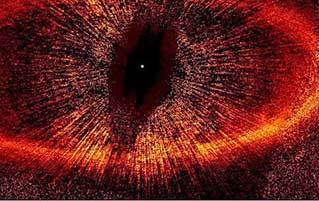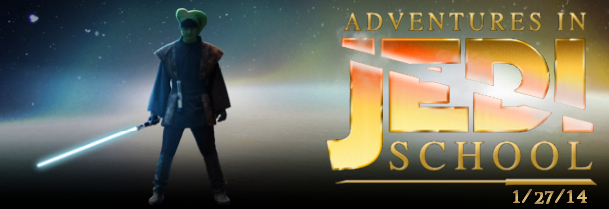5 Real Planets Way Weirder Than Anything in Science Fiction

Movies and TV often present us with strange, alien worlds, and those worlds are often "themed" -- like a planet that's just a giant forest, or a vast snow desert, or full of Nazis. Obviously, that's not how planets work. Everybody knows the only "theme" a real planet can have is unbridled, awestruck terror. Like so ...
The Light-Eater Planet

Try to imagine hell as a planet. Some of you probably thought of an ominous, red, glowing rock with temperatures hot enough to melt a Terminator, while others thought of a giant black ball of death where light literally goes to die. Congratulations: Collectively, you've all just imagined the distant giant known as TrES-2b.

Abandon all hope ye who orbit here.
Orbiting a star in Draco, the constellation of the dragon (little known fact: most of space was named by John Carpenter), TrES-2b is the darkest planet humans have ever discovered. How dark are we talking about here? It absorbs (or "feasts on," if you will) 99 percent of the sunlight that reaches it, making it darker than coal, black acrylic paint, or your ex's cold, unforgiving heart. And it's not likely to ever go hungry, because the planet is located only 3 million miles from its star. In astronomical terms, that's like standing close enough to another person for your nose hairs to get tangled up.

Also, the breath of the person standing too close is hot enough to vaporize uranium.
But hey, it also means that you can now stop worrying about someday being marooned on the Planet of Darkness and going insane ... because you'd probably first be killed by temperatures approaching one-fifth that of the surface of the sun, which have spotted the black surface of the planet with pools of hell magma.

Good news for hot tub enthusiasts, we suppose.
So TrES-2b absorbs almost all light that comes its way, and the only broken sections in the sea of black are Earth-size spots of burning death. The unholy temperatures have made it impossible for clouds to form on TrES-2b, which some researchers think might contribute to the planet's pitch-black appearance. But that wouldn't completely explain the planet's appetite for sunlight. Theories abound: It might be due to the lack of any real atmosphere, or it might be the fault of light-absorbing particles like vaporized sodium or gaseous titanium oxide floating around the planet. Personally, we think it's because the loose tectonic plates of the planet's surface have literally been tainted black after millennia of sliding about on a solid core of ultra-dense hate.
The Planet Traveling Through the Eye of Sauron

The "Eye of Sauron" is the magnificently geeky nickname given to a young star called Fomalhaut and the space debris surrounding it, which, when put together, totally look like a gigantic eye in outer space ...
Unblinking ...
Eternal ...
Watching you shower through the lens of infinity ...

Which may explain why we keep hearing "DON'T FORGET THE TAINT" in a booming voice from the heavens.
But that's all stupid anthropomorphization. Why rely on that, when the true facts are even more existentially terrifying? For example: The debris field is a gigantic disk of rocks and ice roughly twice as wide as the entire solar system. That's the scale we're dealing with here -- and you think your whole day is ruined when the Starbucks girl doesn't get your latte right. Located 25 light-years away from Earth, Fomalhaut b is a Jupiter-size celestial body orbiting the star in the center of Sauron's eye. Since it is but a seagull in the most majestic celestial garbage dump, it's highly probable that the planet is eternally plowing into space junk, resulting in a cosmic fireworks display of burning rocks and exploding ice.

It's everything heavy metal has been promising us for the last 40 years.
It gets worse when you consider that Fomalhaut b might be going through this cruel cycle only because another planet pushed it out of a closer orbit around the star, dooming it to a life of perpetual destruction. That's the closest thing you can get to a Space Curse, and it might make for a pretty decent sci-fi horror flick (only, you know, with planets instead of people -- we're thinking Sarah Michelle Gellar as Fomalhaut b. And not just because she'd look good in a nice, low-cut, form-fitting debris field).

Wow. Astronomy is really coming alive.
The Evaporating Planet

KIC 12557548 b is a planet slowly being tortured to death by its own star. All right, maybe that's a bit overwrought. Let's find a less dramatic way to phrase it: Astronomers have discovered an exoplanet that's literally evaporating from existence before our eyes as it leaves a dusty comet trail behind it like the bloody drag marks of a murder victim desperately crawling for help that will never come. There. Much more scientifically accurate.

This is basically Saw for astronomers.
The planet orbits its star every 16 hours, meaning that KIC 12557548 b's surface temperatures are too hot for rocks, minerals, and even that guy who wears shorts in the dead of winter to exist. But that's not enough: The universe apparently took a look at the dying KIC 12557548 b and its melting mountains and rivers of magma and decided that it just hasn't suffered enough. KIC 12557548 b also displays planet-wide volcanic eruptions so powerful that they shoot ash into space. There, the ash is evaporated by cosmic radiation, because nothing escapes KIC 12557548 b.

Even this planet doesn't want to live on this planet anymore.
But enough about KIC 12557548 b. Let's talk about you: special, beautiful you ...
... and all the horrible things that would happen to you if you set foot on KIC 12557548 b.
First, you'd see a massive, bright star that took up half of the sky. But the time for marveling at a sky of fire is over, because you're struggling to breathe in an atmosphere of 90 percent powdered rock. Then, if the numerous earthquakes and volcanic eruptions didn't immediately do you in (of course they would -- you'd be dead in nanoseconds, but for the purposes of this narrative you get to live for several horrible, clawing minutes), you would be swept up into space and evaporated with the other 100,000 tons of mass that disappear off the planet every second.

Making it a sort of cosmic Detroit, but with higher property values.
The Planet Getting Hit by Drive-Bys

Kepler-36b is a small, rocky planet about 1.5 times the size of Earth. For eons, it has been the subject of constant abuse by its big brother Kepler-36c, a Neptune-like gas giant. The two planets circle a star in the Cygnus constellation more closely than any other planetary system we know about. This unfortunately means that once in a while they get close enough for the larger globe to cause some serious damage to the smaller one. When the two Keplers move into perfect alignment, the larger 36c basically executes a drive-by on 36b, only instead of bullets, it uses its massive gravitational force to turn its rocky sibling into earthquake central, triggering volcanic devastation all across its surface.

Puts Biggie/Tupac into some perspective.
The worst part is that 36b doesn't even have one shaky moment to recover between these attacks. By the time volcanoes finish erupting all over the planet, 36c is back in the neighborhood, stinking of cheap hooch and wrecking up the place again. It happens every 97 days, like clockwork. Kepler-36b has been experiencing near-total devastation every three months, starting back when Cthulhu was just beginning to hit puberty, and yet it still stands, presumably growing angrier each day. We all know how this story goes: You can only push the little guy so far before he snaps and starts stabbing somebody with a fork during Thanksgiving dinner. We give Kepler-36c a few more millennia until its little brother finally can't take any more and kicks it in whatever the planet equivalent of an ass is.
The South Pole?
The Planet Where Glass Rains Sideways at 4,000 mph

HD 189773b's outward appearance is deceptive. At first glance, it's probably the closest to Earth's distinctly habitable look that you'll find: another plain old blue ball, no rings or flames or unyielding blackness. It looks like it might even have clouds or sentient alien life forms that haven't yet discovered what irredeemable assholes we are. Why aren't we on our way there yet?!

"But all my shit is here."
Unfortunately, HD 189773b is a bit of a cosmic exploration cocktease. Far from habitable, HD 189773b is a planet where it literally rains shards of glass.
HD 189773b has a large amount of silicate particles in its atmosphere that happen to scatter blue light. This blue coloring is made all the more prominent when temperatures on the planet (roughly the same ones as those inside a volcano) condense the silicate particles into glass and fling them down and sideways at speeds up to 4,000 mph. Yep: a global glass tornado. That's a premise so outlandish, even SyFy wouldn't touch it. So while it may look like a lovely vacation spot, just remember that HD 189773b is not so much a planet as it is the largest blender in the known universe.

Perfect for those who enjoy their smoothies with a generous helping of hypersonic glass shards.
Andrew is a writer, musician, and aspiring biologist.
Do you dream of designing T-shirts and rolling around in the dollar bills that result from that design? Because if you enter our latest T-shirt contest, that dream could come true. Post your terrifying re-imaginings of a cultural icons and you could win $500.
Always on the go but can't get enough of Cracked? We have an Android app and iOS reader for you to pick from so you never miss another article.
Related Reading: Still not convinced? Gliese 436 is coated in burning ice. Oh yeah, and somewhere out there is a whole planet made of diamond. If your mind isn't blown yet, maybe these creepy sounds from space can do the trick.
